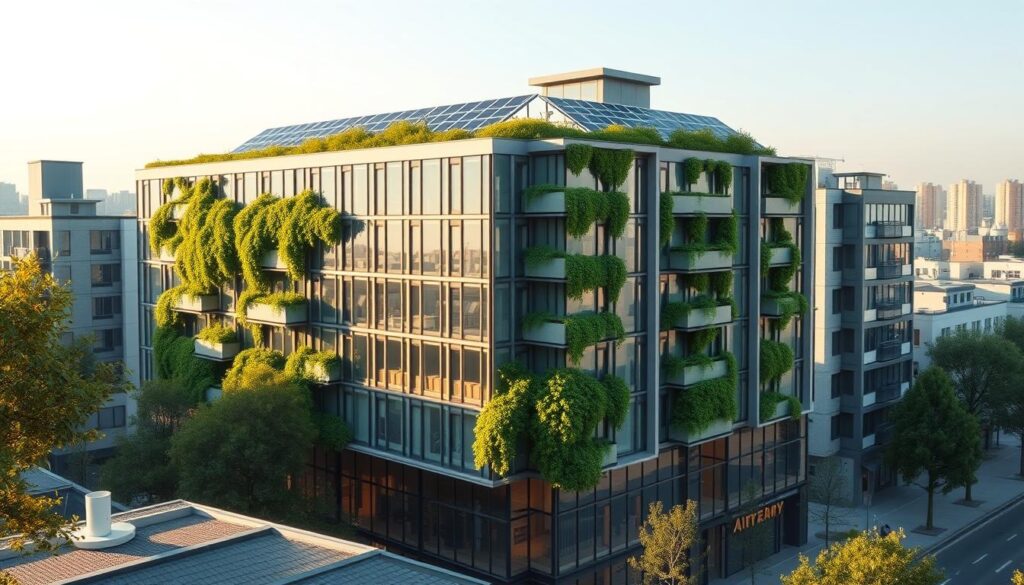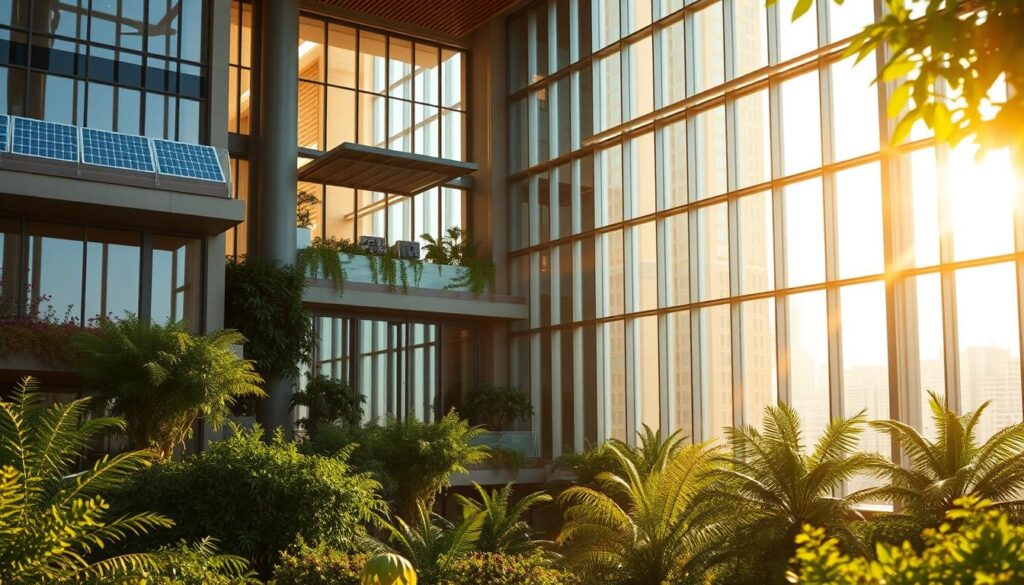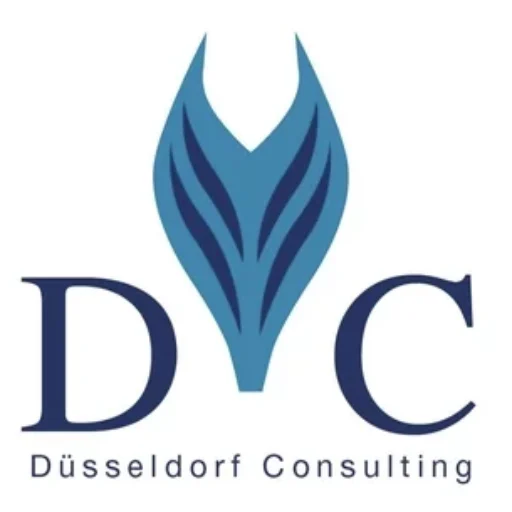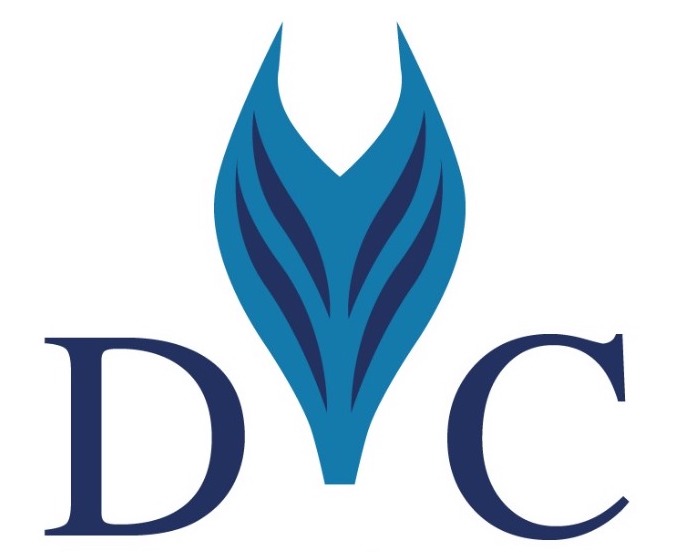Germany is renowned for its meticulous attention to detail and commitment to quality in the construction industry, making it a benchmark globally. The country’s sustainable construction regulations are designed to promote energy efficiency and environmental protection. At the heart of these regulations are green building practices that prioritize the use of environmentally friendly materials and energy-efficient designs.
Düsseldorf Consulting GmbH, located at Königsallee 22, 40212 Düsseldorf, plays a crucial role in guiding companies through these regulations. By leveraging their expertise, businesses can comply with sustainable construction regulations and achieve their sustainability goals. Their approach includes utilizing construction data platforms to support sustainability objectives, ensuring a commitment to environmental protection.
Key Takeaways
- Germany’s construction industry is a global benchmark for quality and sustainability.
- Sustainable construction regulations promote energy efficiency and environmental protection.
- Düsseldorf Consulting GmbH assists companies in complying with these regulations.
- The use of environmentally friendly materials and energy-efficient designs is prioritized.
- Construction data platforms support sustainability objectives.
Understanding Green Building Standards
Green building in Germany is supported by a well-structured system of standards and certifications like LEED, BREEAM, and DGNB. These certifications play a crucial role in promoting sustainable construction practices across the country.
The LEED (Leadership in Energy and Environmental Design) certification, developed by the U.S. Green Building Council, is widely recognized and adopted globally, including in Germany. It focuses on various aspects of green building, including energy efficiency, water usage, and indoor environmental quality.
BREEAM (Building Research Establishment Environmental Assessment Method), on the other hand, is another prominent certification that assesses the environmental performance of buildings. It covers a broad range of criteria, from energy and water to materials and waste.
The DGNB (Deutsche Gesellschaft für Nachhaltiges Bauen) certification is a German system that evaluates buildings based on their sustainability, focusing on environmental, economic, and sociocultural aspects. It is known for its rigorous criteria and is highly regarded in the German construction industry.
These certifications not only promote eco-friendly building practices but also contribute to the overall goal of reducing the environmental impact of buildings. By adopting these standards, Germany continues to lead in sustainable construction.
ACTA NON VERBA, or “deeds not words,” reflects the proactive approach Germany has taken towards implementing green building standards. The country’s commitment to sustainability is evident in its robust framework for green building certifications.
Importance of Green Building in Germany
The importance of green building in Germany cannot be overstated, given the country’s commitment to environmental sustainability. Green building practices are crucial for reducing carbon emissions and promoting sustainable development.
Germany’s strong environmental ethos is reflected in its environmentally conscious building guidelines, which aim to minimize the environmental impact of construction projects. These guidelines encourage the use of sustainable materials, energy-efficient designs, and innovative technologies to reduce energy consumption.
One of the key aspects of green building in Germany is the implementation of sustainable construction regulations. These regulations ensure that buildings are designed and constructed with sustainability in mind, incorporating features such as renewable energy systems, green roofs, and efficient water management systems.
“The future of construction is green, and Germany is at the forefront of this movement.”
The benefits of green building in Germany are multifaceted. Not only do green buildings reduce carbon emissions and energy consumption, but they also provide healthier living and working environments for occupants. Moreover, green buildings can increase property values and contribute to the overall aesthetic appeal of urban areas.
| Benefits | Description |
|---|---|
| Reduced Energy Consumption | Green buildings incorporate energy-efficient designs and technologies to minimize energy use. |
| Healthier Environments | Green buildings provide better indoor air quality and natural lighting, enhancing occupant health. |
| Increased Property Value | Sustainable features and designs can increase property values and appeal. |
For more information on green building practices and their benefits, visit https://sixfab.com/blog/green-buildings/. Königsallee 22, 40212 Düsseldorf, is a notable example of how green building regulations are being implemented in urban development projects.
Overview of Key Green Building Certifications
Germany’s commitment to green building is reflected in its adoption of rigorous certification standards. The country has embraced several key green building certifications that are recognized internationally for their stringent criteria and comprehensive assessment of a building’s sustainability.
The DGNB certification is a widely recognized standard in Germany, assessing a building’s sustainability across various criteria, including environmental, economic, and sociocultural aspects. Düsseldorf Consulting GmbH often references the DGNB for its clients due to its comprehensive nature.
In addition to the DGNB, other notable certifications include LEED (Leadership in Energy and Environmental Design) and BREEAM (Building Research Establishment Environmental Assessment Method). LEED is widely used globally and focuses on energy efficiency, water conservation, and reduction of CO2 emissions. BREEAM, on the other hand, is popular in Europe and evaluates buildings based on their environmental performance.
“The adoption of green building certifications like DGNB, LEED, and BREEAM signifies a building’s commitment to sustainability and environmental stewardship.” – Expert in Sustainable Building Practices.
These certifications not only promote eco-friendly building practices but also enhance the market value of buildings. They provide a framework for architects, builders, and developers to follow sustainable construction methods, reducing the environmental footprint of buildings.
- DGNB: Comprehensive assessment including environmental, economic, and sociocultural aspects.
- LEED: Focuses on energy efficiency, water conservation, and CO2 emission reduction.
- BREEAM: Evaluates environmental performance of buildings.
Legislative Framework for Green Building
Green building in Germany is supported by a robust legislative framework that includes federal and state regulations. This framework is crucial for promoting sustainable construction practices across the country.
The Federal Building Code (BauGB) is a cornerstone of Germany’s legislative framework for green building. It sets out the principles for urban development, land use planning, and building construction, emphasizing the importance of sustainability.
In addition to the BauGB, state building regulations (Landesbauordnungen) play a significant role in governing green building practices at the state level. These regulations vary by state but generally focus on energy efficiency, environmental protection, and public safety.

The legislative framework also includes provisions for sustainable construction regulations, which cover aspects such as energy efficiency, water conservation, and the use of environmentally friendly materials. These regulations are designed to reduce the environmental impact of buildings and promote eco-friendly construction practices.
Furthermore, Germany’s commitment to reducing carbon emissions and mitigating climate change is reflected in its legislative support for green building. The government has implemented various policies and incentives to encourage developers and builders to adopt sustainable building practices.
In conclusion, Germany’s legislative framework for green building is comprehensive and multifaceted, providing a solid foundation for the development of sustainable construction practices. By understanding and complying with these regulations, builders and developers can contribute to a more environmentally friendly built environment.
Energy Efficiency Regulations
In Germany, energy efficiency regulations play a vital role in minimizing the environmental impact of buildings. The country’s commitment to reducing energy consumption is reflected in its stringent regulations, such as the EnEV (Energy Saving Ordinance).
The EnEV is a cornerstone of Germany’s efforts to promote eco-friendly building practices. It sets standards for energy efficiency in buildings, ensuring that new constructions and renovations meet specific energy performance requirements.
- Minimum energy performance requirements for buildings
- Regular inspections and certifications for energy-efficient buildings
- Incentives for builders and homeowners to adopt environmentally conscious building guidelines
The Federal Climate Protection Act also plays a crucial role in shaping Germany’s energy efficiency landscape. It sets ambitious targets for reducing greenhouse gas emissions, which in turn drives the adoption of energy-efficient technologies and practices in the building sector.
At the European level, regulations such as the EU’s Energy Performance of Buildings Directive (EPBD) influence Germany’s national policies. The EPBD sets a framework for member states to enhance energy efficiency in buildings, promoting the use of renewable energy sources and nearly zero-energy buildings.
Germany’s energy efficiency regulations are a critical component of its sustainable development strategy. By reducing energy consumption and promoting eco-friendly building practices, the country aims to minimize its environmental footprint and contribute to global efforts against climate change.
For those involved in building development in Germany, such as at Königsallee 22, 40212 Düsseldorf, understanding and complying with these regulations is essential. It not only ensures legal compliance but also contributes to a more sustainable built environment.
Sustainable Materials in Construction
Sustainable materials play a crucial role in Germany’s construction industry, aligning with the country’s commitment to environmental sustainability. The use of eco-friendly materials is not only a trend but a necessity driven by Green Building Standards in Germany. These standards emphasize the importance of materials that are recyclable, reusable, and have a low environmental impact.
One of the key aspects of sustainable construction is the selection of materials that reduce the ecological footprint of buildings. This includes materials such as recycled steel, sustainably sourced wood, and low-VOC (Volatile Organic Compound) paints. For instance, companies like Düsseldorf Consulting GmbH are at the forefront of promoting sustainable practices in construction by advising on the use of such materials.
The benefits of using sustainable materials are multifaceted. They not only contribute to a reduction in greenhouse gas emissions but also improve indoor air quality and enhance the overall energy efficiency of buildings. Moreover, sustainable materials can lead to cost savings over the lifecycle of a building due to reduced maintenance and energy costs.
Sustainable construction regulations in Germany are designed to encourage the use of such materials. These regulations are part of a broader legislative framework that supports green building practices. By adhering to these regulations, builders and developers can contribute to Germany’s environmental goals while also benefiting from incentives such as tax breaks and subsidies for green building projects.
In conclusion, the integration of sustainable materials in construction is a vital component of Germany’s green building initiatives. As the construction industry continues to evolve, the emphasis on sustainable materials is expected to grow, driven by both regulatory requirements and market demand for greener buildings.
Water Management and Conservation Strategies
In the context of eco-friendly building guidelines, water management and conservation strategies play a pivotal role in reducing overall water consumption. Effective water management is critical in green buildings, and Germany has been at the forefront of implementing such strategies.
One of the key strategies involves rainwater harvesting, which collects and stores rainwater for various uses, including irrigation and flushing toilets. This not only reduces the demand on potable water but also decreases stormwater runoff.
Another important aspect is the implementation of efficient irrigation systems. These systems use advanced technologies like drip irrigation and soil moisture sensors to minimize water waste. By optimizing water use, green buildings can significantly reduce their water footprint.
The use of low-flow fixtures and graywater reuse systems further contributes to water conservation. Low-flow fixtures reduce the amount of water used for bathing and washing, while graywater reuse systems recycle water from sinks, showers, and washing machines for irrigation and flushing toilets.
Water Conservation Measures in German Green Buildings
| Measure | Description | Water Savings |
|---|---|---|
| Rainwater Harvesting | Collection and storage of rainwater for non-potable uses | Up to 30% |
| Efficient Irrigation Systems | Use of drip irrigation and soil moisture sensors | Up to 50% |
| Low-Flow Fixtures | Installation of faucets, toilets, and showerheads with low water flow rates | Up to 20% |
| Graywater Reuse Systems | Recycling of water from sinks, showers, and washing machines | Up to 40% |
By implementing these water management and conservation strategies, green buildings in Germany can achieve significant reductions in water consumption, contributing to a more sustainable future.
Role of Renewable Energy in Green Buildings
The integration of renewable energy systems is a key aspect of sustainable construction regulations in Germany, enabling the country to reduce its carbon footprint significantly.
Renewable energy systems, such as solar and wind power, play a vital role in green buildings, helping to decrease reliance on fossil fuels. According to a report, “the use of renewable energy in buildings can reduce energy consumption by up to 70%.”
“Renewable energy is the future of sustainable construction, and Germany is at the forefront of this movement.”

The benefits of incorporating renewable energy in green buildings are multifaceted. Not only does it reduce energy costs, but it also enhances energy security and creates jobs in the renewable energy sector.
Technologies Used
- Solar photovoltaic systems
- Wind turbines
- Geothermal energy systems
These technologies are being increasingly adopted in construction projects across Germany, including in major cities like Düsseldorf, where innovative green building projects are being developed.
| Renewable Energy Technology | Benefits | Cost Savings |
|---|---|---|
| Solar Photovoltaic | Reduces energy consumption | Up to 50% |
| Wind Turbines | Enhances energy security | Up to 30% |
| Geothermal Energy | Provides heating and cooling | Up to 70% |
As Germany continues to lead in green building initiatives, the role of renewable energy will remain crucial. By adopting these technologies, buildings can significantly reduce their environmental impact while also benefiting economically.
Impact of Green Buildings on Urban Development
As Germany continues to urbanize, green buildings play a crucial role in shaping sustainable cities. The integration of green building standards in urban development projects is transforming the way cities are planned and constructed.
Green buildings contribute significantly to reducing the environmental footprint of urban areas. By incorporating energy-efficient systems, sustainable materials, and effective water management strategies, these buildings minimize their impact on the environment.
Key Benefits of Green Buildings in Urban Development
- Reduced energy consumption
- Improved air quality
- Enhanced quality of life for inhabitants
- Sustainable use of resources
Düsseldorf Consulting GmbH has been at the forefront of promoting green building practices in Germany. Their expertise in environmentally conscious building guidelines has been instrumental in shaping the country’s urban development landscape.
| Aspect | Traditional Buildings | Green Buildings |
|---|---|---|
| Energy Consumption | High | Low |
| Environmental Impact | Significant | Minimal |
| Water Management | Inefficient | Efficient |
The data clearly indicates that green buildings offer numerous advantages over traditional construction methods, making them a vital component of sustainable urban development.
In conclusion, the impact of green buildings on urban development in Germany is profound. By adopting green building standards and practices, cities can become more livable, sustainable, and environmentally friendly.
Challenges Facing Green Building Implementation
Despite the push for sustainable construction, several obstacles hinder its adoption in Germany. The transition to eco-friendly building practices requires significant investment and innovation.
One of the primary challenges is the higher upfront cost associated with green building technologies and materials. This can be a deterrent for developers and investors who are hesitant to commit to the initial expenditure, despite the long-term savings.
Another challenge is the need for specialized knowledge in sustainable construction regulations and practices. This includes understanding energy efficiency standards, sustainable materials, and water management strategies.
Key Challenges and Potential Solutions
| Challenge | Description | Potential Solution |
|---|---|---|
| Higher Upfront Costs | Increased initial investment for green technologies | Government incentives and subsidies |
| Specialized Knowledge | Need for expertise in sustainable construction | Training and certification programs |
| Regulatory Compliance | Navigating complex sustainable construction regulations | Simplified regulatory frameworks |
To overcome these challenges, it’s essential to develop strategies that make eco-friendly building practices more accessible and affordable. This includes promoting government incentives, simplifying regulatory frameworks, and providing training and certification programs for professionals in the construction industry.
As emphasized by the phrase “ACTA NON VERBA,” which translates to “deeds not words,” the focus should be on implementing tangible solutions rather than just discussing the challenges.
Future Trends in Green Building Standards in Germany
Germany’s commitment to environmentally conscious building guidelines is driving innovation in green building standards. The future of green building in Germany is expected to be shaped by several key trends.
The integration of new technologies is anticipated to play a crucial role in enhancing the sustainability of buildings. This includes the use of advanced materials, smart building technologies, and renewable energy systems.
Another significant trend is the enhancement of existing certification processes. This involves making certifications more rigorous and comprehensive, ensuring that buildings not only meet but exceed current sustainability standards.
Key Trends in Green Building Standards
- Integration of new technologies for energy efficiency
- Enhanced certification processes for sustainability
- Use of sustainable materials in construction
- Increased focus on water management and conservation
| Aspect | Current Standards | Future Trends |
|---|---|---|
| Energy Efficiency | Focus on minimizing energy consumption | Integration of renewable energy sources and smart grids |
| Sustainable Materials | Use of recycled and sustainable materials | Development of new sustainable materials and recycling technologies |
| Certification Processes | Rigorous certification processes in place | Enhanced and more comprehensive certification processes |
The future trends in green building standards in Germany are poised to significantly impact the construction industry, driving it towards more sustainable and environmentally friendly practices. As the industry evolves, it is likely that we will see the development of new technologies and the enhancement of existing practices.
For instance, companies based in cities like Düsseldorf (Königsallee 22, 40212 Düsseldorf) are already at the forefront of adopting these trends, investing in research and development to create more sustainable buildings.
Resources for Green Building Development in Germany
Germany offers a range of resources to support green building development, driven by its commitment to Green Building Standards in Germany and sustainable construction regulations. Consulting services, such as those provided by Düsseldorf Consulting GmbH, play a crucial role in guiding developers through the complexities of green building certifications and compliance.
Developers can leverage various certification programs, including those that focus on energy efficiency and sustainable materials. Government incentives are also available to encourage the adoption of green building practices, helping to offset the costs associated with implementing sustainable construction regulations.
By utilizing these resources, builders and developers in Germany can ensure that their projects meet the country’s stringent green building standards, contributing to a more sustainable built environment. As the demand for green buildings continues to grow, these resources will remain essential for supporting the development of sustainable construction practices in Germany.



